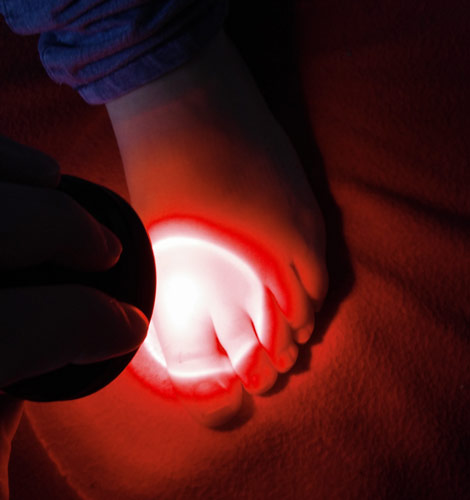Light Therapy and Arthritis
Medical & Healthcare Disclaimer
The information contained in this article is not intended or implicitly suggested to be an alternative for professional diagnoses, or profesionally recommended treatments & medical advice. Absolutely all of the content, including the article text itself, images, comments and other information, contained on this web page is for non-specific information purposes only. We strongly suggest that one should never ignore professional health/medical advice and we strongly suggest that one must not delay seeking a professionally recommended medical treatment because of information attained via reading this article/website. The products sold or recommended on this web site are absolutely not for the diagnosis, prevention, monitoring, treatment or alleviation of any specific disease, injury or disability.
Introduction
Light therapy and its use on arthritis
The mechanism – what red/infrared light does
Causes
Arthritis can be the result of chronic inflammation of a joint, but can also develop suddenly, after periods of stress or injury (not necessarily injury to the arthritic area). Usually the body is able to repair the daily wear and tear on joints, but can lose this ability, leading to the onset of arthritis. A reduction in oxidative metabolism, the ability to convert glucose/carbohydrates into energy is linked strongly to arthritis.- Clinical hypothyroidism is frequently associated with arthritis30, with both often diagnosed around the same time.
- More recent studies have shown more details of the metabolic defect in glucose metabolism is linked to rheumatoid arthritis (http://scopeblog.stanford.edu/2013/09/16/important-metabolic-defect-identified-in-immune-cells-of-rheumatoid-arthritis-patients/)
- This is shown by how becoming pregnant can completely clear up (or at least change) arthritic symptoms in some women.
- Rheumatoid arthritis is also 3+ times more frequent in women than in men (and harder to women to cure), further confirming the hormonal link.
- Adrenal hormones (or lack thereof) have also been linked to all arthritis for over 100 years now20.
- Changes in liver health/function are strongly linked to rheumatoid arthritis
- In fact, abnormal calcium metabolism is present in all types of arthritis.
Mechanism
- * Reactive oxygen species (ROS) are released in small amounts after light therapy.
- * Vasodilation is potentially stimulated by red/IR light therapy – something related to NO and very significant for joint inflammation and arthritis.
Red or Infrared?
Ensuring penetration to the joints
The two main things affecting tissue penetration are the wavelengths and the strength of the light hitting the skin. In practical terms, anything below the wavelength of 600nm or over the wavelength of 950nm won’t penetrate deeply. The 740-850nm range seems to be the sweet spot for optimal penetration and around 820nm for maximum effects on the cell. Strength of the light (aka power density / mW/cm²) also affects penetration with 50mW/cm² over a few cm² area being a good minimum. So essentially, this boils down to adevice with wavelengths in the 800-850nm range and greater than 50mW/cm² power density.
Summary
- * Light studies look at all types of arthritis; osteo, rheumatoid, psoriatic, juvenile, etc.
- * Any wavelength between 600nm and 1000nm is studied.
- * Infrared light around the 825nm range seems best for penetration.
References
- Low level laser therapy for osteoarthritis and rheumatoid arthritis: a metaanalysis. Brosseau et al. 2000.
- Low level laser therapy (Classes I, II and III) for treating osteoarthritis. Brosseau et al. 2004.
- Effect of low-level laser therapy on the expression of inflammatory mediators and on neutrophils and macrophages in acute joint inflammation. Alves et al. 2013.
- Can osteoarthritis be treated with light? Michael R Hamblin, 2013.
- Effect of low-level laser therapy (904 nm) and static stretching in patients with knee osteoarthritis: a protocol of randomised controlled trial. Ferreira de Meneses et al. 2015.
- Does addition of low-level laser therapy (LLLT) in conservative care of knee arthritis successfully postpone the need for joint replacement? Ip et al. 2015.
- High-intensity versus low-level laser therapy in the treatment of patients with knee osteoarthritis: a randomized controlled trial. Kheshie et al. 2014
- Short-term efficacy of physical interventions in osteoarthritic knee pain. A systematic review and meta-analysis of randomised placebo-controlled trials. Bjordal et al. 2007.
- Efficacy of low-level laser therapy applied at acupuncture points in knee osteoarthritis: a randomised double-blind comparative trial. Al Rashoud et al. 2014.
- Effect of low-level laser therapy in patients with chronic knee osteoarthritis: a single-blinded randomized clinical study. Alghadir et al. 2014.
- Influence of various laser therapy methods on knee joint pain and function in patients with knee osteoarthritis. Gworys et al. 2012.
- Efficacy of low level laser therapy associated with exercises in knee osteoarthritis: a randomized double-blind study. Alfredo et al. 2012.
- The effect of low-level laser in knee osteoarthritis: a double-blind, randomized, placebo-controlled trial. Hegedus et al. 2009.
- Synergic effects of ultrasound and laser on the pain relief in women with hand osteoarthritis. Paolillo et al. 2015.
- A systematic review of low level laser therapy with location-specific doses for pain from chronic joint disorders. Bjordal et al. 2003.
- Meta-Analysis of Pain Relief Effects by Laser Irradiation on Joint Areas. Ho Jang et al. 2012.
- Low Level Laser Therapy (LLLT) for Neck Pain: A Systematic Review and Meta-Regression. Anita R Gross et al. 2013.
- The influence of intravenous laser irradiation of the blood on the dynamics of leptin levels and the quality of life of the patients presenting with rheumatoid arthritis. Burduli et al. 2015.
- Reduction of IL-20 Expression in Rheumatoid Arthritis by Linear Polarized Infrared Light Irradiation. Imaoka et al. 2014.
- Treatment of Rheumatoid Arthritis with ATP. Birger Carlström and Olle Lövgren. 1949.
- Low-level laser therapy in different stages of rheumatoid arthritis: a histological study. Alves et al. 2013.
- Low-level laser therapy for zymosan-induced arthritis in rats: Importance of illumination time. Castano et al. 2007.
- Effects of low-level laser therapy at wavelengths of 660 and 808 nm in experimental model of osteoarthritis. da Rosa et al. 2012.
- Anti-inflammatory activities of light emitting diode irradiation on collagen-induced arthritis in mice (a secondary publication). Kuboyama et al. 2014.
- Photobiomodulation of pain and inflammation in microcrystalline arthropathies: experimental and clinical results. Soriano et al. 2006.
- Low-level laser therapy stimulates tissue repair and reduces the extracellular matrix degradation in rats with induced arthritis in the temporomandibular joint. Lemos et al. 2016.
- Effect of low-level laser on healing of temporomandibular joint osteoarthritis in rats. Peimani et al. 2014.
- Effect of light-emitting diode (LED) therapy on the development of osteoarthritis (OA) in a rabbit model. Oshima Y. 2011.
- Efficacy of low-level laser therapy in the management of neck pain: a systematic review and meta-analysis of randomised placebo or active-treatment controlled trials. Chow et al. 2009.
- Rheumatoid arthritis and thyroid abnormalities. Staykova. 2007.
- Laser Ther. 2011; 20(3): 205–215. Is light-emitting diode (LED) phototherapy really effective? Won-Serk Kim and R Glen Calderhead
- An Bras Dermatol. 2014 Jul-Aug;89(4):616-23. Effects of low-power light therapy on wound healing: LASER x LED. Chaves ME et al., 2014.
- Improvement of pain and disability in elderly patients with degenerative osteoarthritis of the knee treated with narrow-band light therapy. Stelian et al. 1992.
- In chronic low back pain, low level laser therapy combined with exercise is more beneficial than exercise alone in the long term: a randomised trial. Djavid et al. 2007.
- Laser therapy: a randomized, controlled trial of the effects of low-intensity Nd:YAG laser irradiation on musculoskeletal back pain. Basford et al. 1999.
- Evaluation of low-level laser therapy in the treatment of temporomandibular disorders. Cetiner et al. 2006.
- Lasertherapy efficacy in temporomandibular disorders: control study. Santos Tde et al. 2010.
- Low-power laser treatment in patients with frozen shoulder: preliminary results. Stergioulas. 2008.
- Exact action spectra for cellular responses relevant to phototherapy. Karu et al. 2005.
- Positive effects of low level laser therapy (LLLT) on Bouchard’s and Heberden’s osteoarthritis. Baltzer et al. 2016
